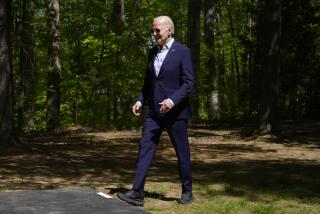Shell gets conditional approval for U.S. Arctic drilling plan
Shell Exploration was conditionally cleared Thursday to proceed with the most ambitious oil and gas drilling program ever attempted in the U.S. Arctic, a plan that would offer access to a crucial new domestic energy supply in one of the most environmentally fragile regions on Earth.
After years of legal wrangling by Shell and Arctic conservationists, the exploration plan in the Beaufort Sea off the coast of Alaska was tentatively approved by the federal Bureau of Ocean Energy Management, Regulation and Enforcement, which could clear the way for Shell to begin drilling three exploratory wells as early as next July.
Several key hurdles remain, including federal permits for discharging air pollutants and disturbing the whales, seals, walrus and polar bears that reside near the proposed drilling sites, and those hurdles could easily delay the drilling further, though opponents by now are running short of legal options.
A decision is expected as early as next week on the additional crucial issue of Shell’s plan for cleaning up any oil spilled during drilling operations — a matter of concern because of the fragility of the Arctic environment and the difficulty in cleaning up oil amid ice floes, the towering waves of Arctic storms and the long hours of dark once the autumn drilling season winds to a close.
Conservationists also fear that drilling could disrupt a key resting and feeding area in Camden Bay for endangered bowhead whales.
Shell has a separate application under review to launch up to six exploratory wells in the nearby Chukchi Sea, an operation that also could get underway next year if approvals are in place.
“Shell has come back with the largest and most aggressive drilling proposal we’ve ever seen in the U.S. Arctic. We’ve never seen anything of this scale before in this country,” said Holly Harris, attorney for the environmental law group Earthjustice, which has battled drilling plans in the Arctic.
“This is a disaster waiting to happen…. Scientific integrity and government accountability took their familiar back seat to oil company profits and power today,” she said.
But officials in Alaska who have long been frustrated with lengthy court delays over opening production on what they see as a crucial and obvious new energy resource welcomed the federal agency’s decision, which followed an earlier approval that was tied up by court orders for additional environmental reviews.
“Approval of this exploration plan is fantastic news for Alaska’s oil and gas industry and is a welcome shot in the arm for Alaska’s long-term economic good health,” Sen. Mark Begich (D-Alaska) said. “I’m confident this will ultimately be the first of many developments to keep oil flowing through Alaska’s economic lifeline, the trans-Alaska oil pipeline.”
Shell has pursued its Arctic exploration program for years and spent large amounts of money on scientific studies and response plans, only to face new delays based on continuing concerns that the remote, delicate Arctic region could perhaps not withstand industrial operations offshore and the kind of oil disaster that occurred with last year’s BP spill in the Gulf of Mexico.
After its earlier exploration plan was held up once again last year, Shell came back this spring with an even more ambitious proposal and warnings that the company could not afford to wait forever to get them approved.
“The conditional approval of our plan of exploration is welcome news and adds to our cautious optimism that we will be drilling our Alaska leases by this time next year,” Shell spokesman Curtis Smith said.
But in a conference call organized by the Alaska Wilderness League, conservation leaders and Robert Thompson, an Inupiat resident of Kaktovik, an indigenous village on the Beaufort Sea, expressed doubts that even a small part of a major oil spill could be effectively cleaned up.
“I’ve asked the CEO of Shell if they could clean up oil in the Arctic Ocean…. I got an evasive answer that the latest, best technology would be used,” Thompson said. “It’d be better if they just admitted they couldn’t clean up oil in the ice and say they’re going to do it anyway.”
More to Read
Start your day right
Sign up for Essential California for news, features and recommendations from the L.A. Times and beyond in your inbox six days a week.
You may occasionally receive promotional content from the Los Angeles Times.






